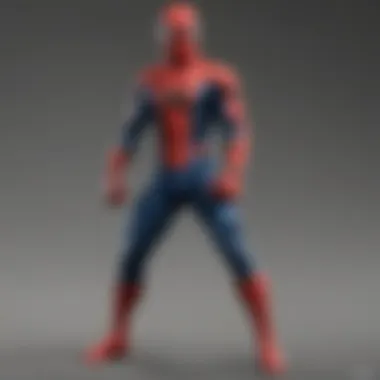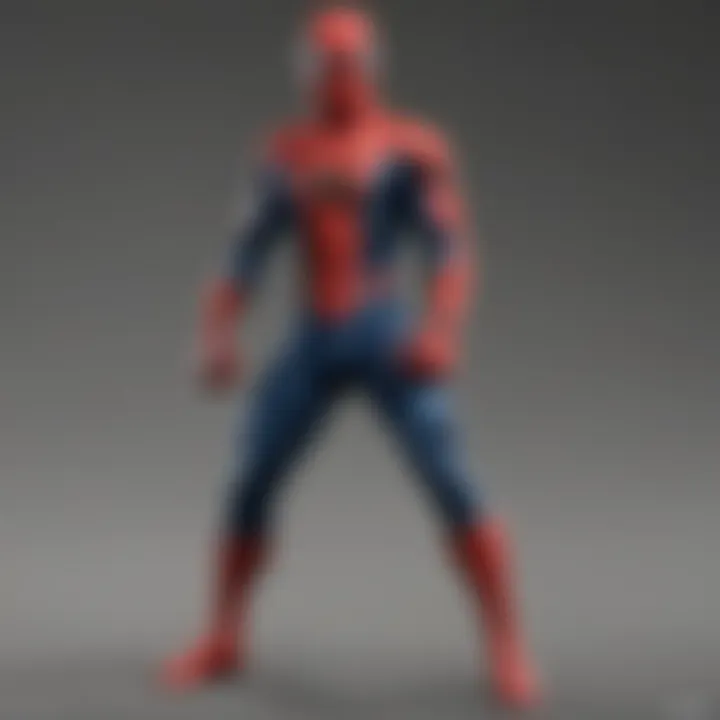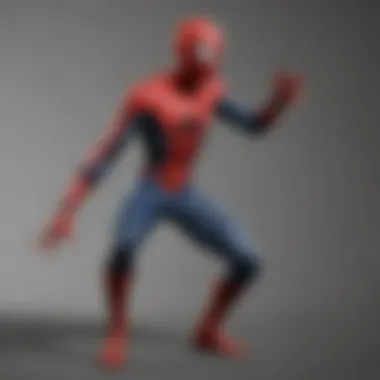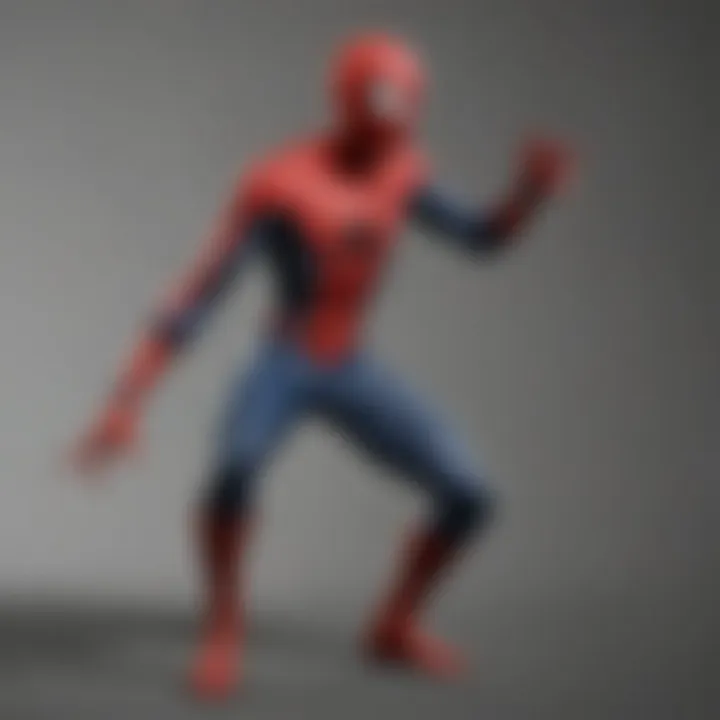Exploring the Evolution of the Amazing Spider-Man Costume


Intro
The realm of comic book superheroes is vast, yet few characters have captured the public’s imagination as Spider-Man has. Central to Spider-Man's identity is the iconic costume that has transformed alongside the character himself. This exploration will illuminate the multifaceted aspects of the Amazing Spider-Man costume, from its inception in comic books to its striking portrayals in modern cinema and its far-reaching cultural impact.
By examining design elements, material use in costume creation, and the significant connection fans share with the costume, the analysis highlights how it serves as a symbol of identity for Spider-Man and his followers. Furthermore, the article will delve into the costume's role in merchandising, cosplaying communities, and appearances in diverse Spider-Man media.
Understanding the Amazing Spider-Man costume is not just about fabric and stitching; it is also about the character's journey and the emotional connections it fosters within the fandom.
Spider-Man Character Analysis
Background
Spider-Man, created by Stan Lee and Steve Ditko, first swung onto comic book pages in 1962. His origin story, rooted in tragedy, reveals the essence of his character. Peter Parker, a socially awkward high school student, receives his powers after being bitten by a radioactive spider. The loss of his Uncle Ben, who famously said, "With great power comes great responsibility," shapes Peter's journey and motivates him to use his powers for good.
Powers and Abilities
Spider-Man possesses a range of unique abilities. He can cling to virtually any surface, providing agility and mobility. His spider-sense, a precognitive ability, alerts him to danger, making him a formidable opponent. Moreover, his strength and endurance are significantly heightened compared to an average human. This is often complemented by his intelligence, which allows him to invent gadgets like web-shooters.
Character Development
Over the decades, Spider-Man has evolved through numerous story arcs and challenges. He has confronted personal losses, formed alliances, and struggled with his dual identity. Key moments such as his battles with the Green Goblin and the emotional turmoil involved in the death of Gwen Stacy mark pivotal points. Each experience adds depth to his character, showcasing not only his growth but also his enduring humanity.
"The evolution of Spider-Man reflects the struggles we all face in balancing power and responsibility."
Latest Spider-Man News Update
Comic Books
Recent comic book releases featuring Spider-Man continue to explore complex themes and character interactions. Titles like The Amazing Spider-Man and Spider-Verse stories reveal fresh adventures while expanding the multiverse concept, offering fans various alternate Spider-People to connect with.
Movies
Upcoming Spider-Man movie releases promise to further immerse audiences in Peter Parker's world. Details about new storylines, casting choices, and trailers keep anticipation high among fans.
Video Games
The universe of Spider-Man video games is also thriving. Recent releases, like Marvel’s Spider-Man: Miles Morales, have introduced new gameplay dynamics and narratives that resonate with the superhero's legacy, ensuring player engagement and excitement.
Top Villains in Spider-Man Universe
Main Antagonists
Spider-Man's rogues' gallery includes some of the most memorable villains in comic lore. Characters like Green Goblin, Doctor Octopus, and Venom present diverse challenges that refine Spider-Man’s character while engaging readers and viewers.
Origins and Motivations
Each villain's backstory adds layers to their confrontations with Spider-Man. For instance, Green Goblin’s madness and personal vendetta make him a tragic figure. Venom, on the other hand, represents the dark side of the Spider-Man mythos, driven by rage and a desire for revenge.
Memorable Battles
Notable battles, such as Spider-Man versus Doctor Octopus in Spider-Man 2, exemplify the high stakes involved. These confrontations often echo the hero's internal struggles, making them rich narratives that resonate deeply with the audience.
Spider-Man Movie Reviews
Plot Summary
The latest Spider-Man films present an evolving narrative, blending humor, action, and drama. This balance ensures that both older fans and new viewers find something appealing.
Character Portrayals


Lead actors consistently bring depth to their portrayals of Spider-Man. Each actor's interpretation adds a unique flavor to the character, from Tobey Maguire's earnestness to Tom Holland's youthful exuberance.
Visual Effects
Recent films showcase exceptional visual effects, enhancing the overall viewing experience. The portrayal of Spider-Man's web-swinging through urban landscapes sets a benchmark for action sequences in superhero cinema.
This exploration aims to encapsulate the richness of the Amazing Spider-Man costume and the character behind it, while providing insights that resonate with both enthusiasts and scholars.
Prolusion to the Spider-Man Costume
The Spider-Man costume is more than just attire; it is an emblem of an enduring legacy in comic books and popular culture. Understanding this costume involves looking at its design origins, the myriad of adaptations it has undergone, and the psychological and cultural significance it holds for fans.
This section introduces the importance of the Spider-Man costume, which serves as a powerful symbol of heroism and the struggle between good and evil. It reflects the character’s identity and resonates deeply with people who relate to his journey. The costume’s unique aesthetics and functionality, including its vibrant colors and web-patterned design, have been critical to its lasting appeal.
Exploring the specifics of this iconic costume enriches our grasp of Spider-Man’s overall narrative and its impact on contemporary culture. Notably, this iconic outfit has also significantly influenced fans' engagement in various areas, including cosplay, entertainment, and merchandise. The ongoing evolution of the Spider-Man costume demonstrates how design can parallel social changes and cultural dynamics.
Historical Background
The origin of the Spider-Man costume dates back to 1962 when Stan Lee and Steve Ditko created the character. Their goal was to develop a superhero who possessed both human and relatable traits, contrasting with the god-like figures common in comics of that era. The first appearance of Spider-Man in Amazing Fantasy #15 showcased a striking costume that combined a simple yet significant color palette of red and blue.
The initial design included a full face mask, which allowed for anonymity, and the web pattern symbolizing his spider-like abilities. This design served not just as a costume, but as a visual representation of Peter Parker's alter ego, emphasizing themes of duality, responsibility, and sacrifice. Over the years, this has been subject to various iterations by different artists and filmmakers, each adding layers to the design while maintaining its core essence.
Cultural Significance
The cultural significance of the Spider-Man costume transcends graphic novels. It has become a symbol of youthful rebellion, hope, and the idea that anyone can become a hero. Furthermore, the costume's widespread recognition can be attributed to the various adaptations in films and television. For many, wearing the Spider-Man costume during Halloween or at conventions is an expression of admiration for the character's values.
The costume also represents community and identity. Fans often connect with Spider-Man because of his struggles and triumphs, reflecting common human experiences. Additionally, this emblematic outfit has led to a thriving cosplay culture, where enthusiasts meticulously recreate the design to showcase their passion for the character. Through these acts of personal expression, the Spider-Man costume embodies a shared connection among diverse groups of fans.
The Spider-Man costume signifies more than superhero status; it reflects personal identity and universal values, fostering a community among fans.
In summary, the Spider-Man costume holds a prominent place in the broader landscape of popular culture, marking its significance in history and contemporary society. Understanding these dynamics sets the stage for the exploration of its design evolution and the impact it has had on various media.
Design Evolution of the Costume
The design evolution of the Spider-Man costume is essential to understanding how the character has developed over time. Each iteration of the costume reflects not only the changes in artistic style but also the cultural shifts that have influenced popular sentiment. By examining the various designs, fans can grasp what the costume symbolizes and how it has grown with the audience it serves.
Original Concept by Stan Lee and Steve Ditko
When Stan Lee and Steve Ditko created Spider-Man in 1962, they laid the groundwork for what would become an iconic character. The original costume was designed to be simple yet effective. It featured a bright red and blue color scheme that made Spider-Man stand out. The web pattern across the suit added depth, almost suggesting movement, which resonated with readers. In a time where superheroes wore capes and masks, the decision to make Spider-Man's costume skin-tight and without a traditional cape was revolutionary. This design emphasized the character's agility and acrobatics, aligning with his spider-like abilities.
Key Variations Over the Decades
Over the decades, Spider-Man's costume has undergone numerous changes. These variations often reflected the artistic movements of their time.
- 1970s to 1980s: This era saw the introduction of the iconic black suit, which debuted in "The Amazing Spider-Man #252". Designed by John Romita Jr., it marked a shift in tone and hinted at darker themes. The black suit would later become synonymous with the Venom character.
- 1990s: During this period, redesigns became more frequent. Artists like Todd McFarlane introduced wider eyes and a more muscular physique, giving Spider-Man a more dynamic look. The arrival of the Clone Saga brought even more variations, with costumes like the Ben Reilly Scarlet Spider suit.
- 2000s and Beyond: The costumes became increasingly detailed, with elements like organic web-shooters and varying designs based on the storylines, such as the different suits seen in the "Ultimate Spider-Man" series. Each variation catered to new audiences while paying homage to earlier designs.
Influence of Artists on Costume Design
Artists have played a vital role in shaping the Spider-Man costume. Their choices have not only catered to aesthetic demands but also addressed the narrative needs of the stories being told.
- Steve Ditko: His original work established much of the visual language for Spider-Man. His minimalist and functional design encapsulated the character’s essence, emphasizing relatability and realism for readers before elaborate designs became a trend.
- Mark Bagley: He is known for refining the character for the 1990s. His interpretation brought a sleeker, slightly more muscular design that resonated with readers of that time.
- Brian Michael Bendis and Sara Pichelli introduced Miles Morales, an alternative Spider-Man with a fresh design that included a black and red color scheme, further diversifying the Spider-Man legacy.
This evolution across decades, influenced by various artists, illustrates how Spider-Man remains relevant, allowing adaptation while preserving its core. It also highlights the art form itself, as each new design aims to echo societal sentiments despite altering fundamental visuals.
"A superhero’s costume often represents the pulse of its time. For Spider-Man, it has been a barometer of society’s expectations of heroism and identity."
Through this design evolution, the Amazing Spider-Man costume continues to capture the imagination of fans, serving not just as a visual representation of a character but also a canvas reflecting the world around the stories.
Material and Construction Techniques


The material and construction techniques of the Spider-Man costume are pivotal to understanding its appeal and functionality. This costume has been crafted through various approaches over the years, which reflect changes in technology and artistry. The use of innovative materials and construction methods contributes directly to the costume's effectiveness in conveying the character's essence while also ensuring that it meets the demands of both cosplayers and film production.
Fabric Choices and Technical Advances
The choice of fabric plays a crucial role in how the Spider-Man costume looks and feels. Traditional spandex, commonly used in superhero costumes, offers flexibility and comfort. It allows for a full range of motion, which is essential for a character known for agility. Modern advancements have led to the introduction of high-tech fabrics that incorporate moisture-wicking and breathability properties. There are also reflective options for added visibility during night scenes in film.
These fabrics enhance the overall performance of the suit. For example, the use of four-way stretch textiles not only improves fit but also moves with the wearer, reducing the likelihood of discomfort during extended wear. The development of these fabrics showcases a significant link between costume design and athletic wear, highlighting a trend where function meets fashion.
3D Printing and Modern Materials
In recent years, 3D printing has revolutionized the way costumes, including Spider-Man's, are constructed. This technology allows for highly detailed designs that were previously impossible to achieve. With 3D printing, costume makers can create intricate components for the costume, such as web-shooters or textured elements on the suit, that seamlessly integrate with soft fabrics.
Additionally, the introduction of modern materials such as EVA foam and thermoplastics in costume creation provides durability while keeping the costume lightweight. Some components can now be made quickly and efficiently, reducing production time significantly. This adaptability in material choice means that creators can experiment with various forms and functionalities.
Modern techniques and materials have pushed the boundaries of traditional costume design, reflecting advancements in both technology and creative expression.
As we look at the evolution of the Amazing Spider-Man costume, it is clear that material selection and construction techniques are not just secondary details. They are fundamental to how the character is represented across various media, ensuring that both the visual language and physicality of Spider-Man maintain coherence and appeal.
Impact of Cinematic Interpretations
The portrayal of the Spider-Man costume in film has significantly shaped public perception of the character. Each interpretation not only reflects the creative vision behind the movies but also impacts how fans engage with and perceive Spider-Man as a whole. This importance lies in multiple elements, ranging from design choices to the emotional connection fans establish with the character when viewed through the lens of cinema.
Sam Raimi's Spider-Man Trilogy
Sam Raimi's Spider-Man Trilogy, starting in 2002, marked a pivotal moment in superhero films. The costume, designed by James Acheson, closely adhered to the original comic design by Steve Ditko, yet it introduced some modern elements. Raimi's choice to keep the classic red and blue color scheme resonated with long-time fans, while practical effects and CGI brought the character's movements to life in a compelling way.
This trilogy's portrayal became iconic for its emphasis on the character’s struggle between personal life and superhero duties. The costume visually represented that duality. Its realistic texture and fit made it visually appealing and relatable, adding depth to the character of Peter Parker.
The Amazing Spider-Man Series
In contrast, The Amazing Spider-Man series saw a redesign that added a contemporary flair to the iconic costume. Designed by Anna Witt, the new suit incorporated a more athletic look with darker reds and blues and a larger emblem across the chest. This change reflected the darker tones and themes of the series, aligning with the character’s struggles and dilemmas. The suit also featured web-shooters that were more mechanical, which aligned with the technological aspect of Peter's character in this iteration. This varied yet faithful approach kept fans intrigued, drawing new spectators while retaining loyal followers from the original trilogy.
The Marvel Cinematic Universe Representation
The Marvel Cinematic Universe's portrayal of Spider-Man, primarily through the character's introduction in Captain America: Civil War, presents yet another evolution of the iconic outfit. Designed by returning costume designer Anna Witt, this version embraces a more youthful and vibrant style, aiming to resonate with a new generation of fans. Incorporating advanced materials and design elements, the costume offers viewers a fresh take while being faithful to its roots.
Tom Holland's version of Spider-Man showcases a suit that is both functional and sleek, adopting a more playful demeanor. Technological integration, including gadgetry like the "instant kill" mode, reflects the advancements in storytelling within the MCU.
The transformation of the Spider-Man costume across films not only showcases design evolution but also illustrates how narrative and thematic changes influence visual representation in cinema.
Overall, the various cinematic interpretations of the Spider-Man costume highlight a broader cultural relevance and the complex relationship fans have with the character. Each film adapts the suit to fit the storytelling needs, making it an essential component of Spider-Man's identity across different eras.
Cosplay and Costuming Culture
Cosplay has developed into a significant aspect of popular culture. Within this article, it is essential to delve into the world of cosplay as it relates to the Amazing Spider-Man costume. Cosplay allows fans to explore their passion for characters deeply. Not only is it a creative outlet, it offers a sense of community among participants. The culture of cosplay fosters connections between individuals with shared interests. It is a way for folks to engage with their favorite media more interactively and imaginatively.
The Rise of Cosplay as a Hobby
The hobby of cosplay has seen substantial growth in recent years. It originated mainly during conventions and fan gatherings but has expanded into online platforms. Many fans begin by creating costumes for events like Comic-Con or Halloween. The accessibility of materials and tutorials on platforms such as YouTube has made it easier for newcomers.
Moreover, Spider-Man fans, in particular, have embraced this hobby. They often share their creations on social media like Reddit or Facebook. This sharing contributes to a larger dialogue about techniques and designs. As costumes become more sophisticated, the community pushes for higher standards in craftsmanship. This trend highlights the merging of fandom and artistry, where characters such as Spider-Man capture the imagination of countless enthusiasts.
Authenticity vs. Creative Interpretation
In the realm of cosplay, two distinct approaches emerge: authenticity and creative interpretation. Authenticity refers to replicating the Spider-Man costume as closely as possible to the comic and film versions. This meticulous approach demonstrates respect for the source material. Enthusiasts often share tips on achieving a true-to-life look, including fabric choices and techniques for accurate detailing.
On the other hand, creative interpretation allows cosplayers to infuse their personalities into the Spider-Man costume. Variations might include alternative colors or artistic adaptations. Some choose to adapt the character for unique themes or mashups with other fandoms.
Both approaches are valid and foster a dynamic environment within the cosplay community. This diversity enriches the culture and encourages dialogue among fans. Ultimately, whether cosplayers prioritize accuracy or creative expression, both contribute to the ongoing legacy of the Amazing Spider-Man costume.
"Cosplay is not just dressing up; it's an art that conveys personal identity through the lens of beloved characters."


In summary, the culture of cosplay surrounding the Amazing Spider-Man costume reveals much about community, identity, and expression. Whether through traditional replication or individual interpretation, the harmony of these elements highlights the costume's significance in contemporary fandom.
Merchandising and Commercialization
Merchandising and commercialization of the Spider-Man costume represent a significant aspect within the broader context of Spider-Man's cultural reach. As the character evolved across various media, the demand for costumes has seen a parallel rise. This commercialization encompasses not just product sales but also the ways fans interact with and embody the persona of Spider-Man through these items.
Licensing opportunities have paved the way for a vast array of products, from authentic replicas to affordable imitations. This diversity caters to a wide range of budgets and preferences among fans. Understanding the nature of this marketplace is crucial.
Some key considerations include:
- Quality: High-quality materials lead to a better representation of the character. Fans often seek products that mirror the intricate design of the original costume.
- Affordability: Availability at various price points ensures that a broader audience can access Spider-Man costumes. This could range from premium-grade outfits to less expensive versions for casual fans or children.
- Seasonal Trends: Halloween and comic conventions are peak times for sales in merchandise. Companies often release limited edition costumes to cater to these annual events.
"The costume is much more than a piece of clothing; it forms a bridge connecting the media franchise with the individual fan."
Costumes in Retail and Online Stores
Retailers have recognized the popularity of the Spider-Man costume. Major toy and clothing stores, such as Walmart and Target, dedicate sections to superhero costumes, especially around Halloween. Online platforms like Amazon and eBay allow for a broader selection, catering to collectors and those seeking rare items.
In many cases, these costumes include:
- Complete outfits that feature masks, bodysuits, and accessories
- Customized options for those who want to make their own unique version
- Kids' sizes to appeal to younger audiences
Additionally, promotional events linked to Spider-Man films and shows often create buzz that drives traffic to retail locations and online stores.
Licensing and Brand Collaborations
Licensing agreements have played a crucial role in the commercial success of Spider-Man costumes. Companies like Rubie's Costume Company and Disguise, Inc. have secured rights to produce official merchandise, thus ensuring authenticity. These partnerships create a win-win situation. Fans receive genuine products, while the partner companies gain access to a dedicated and enthusiastic audience.
Brand collaborations expand beyond costumes to include various product lines. Examples involve:
- Clothing lines featuring designs inspired by Spider-Man's aesthetic
- Thematic merchandise, such as shoes and accessories that reflect the character's watchful nature or agility
- Collectibles, including action figures in costume which cater to adult fans.
The Psychological Connection to Identity
The psychological connection to identity plays a crucial role in understanding the impact of the Amazing Spider-Man costume on fans and the broader culture. It not only reflects individual values but also shapes the way fans perceive themselves. This section explores elements that underline this connection. By dissecting the empathy fans feel towards Spider-Man, the relationship between the costume and self-expression, and how these aspects influence personal identity, we can appreciate why Spider-Man endures as a powerful cultural icon.
Fans Identifying with Spider-Man's Values
Fans often find themselves resonating with Spider-Man's core values. These include responsibility, integrity, and the perpetual battle against adversity. Spider-Man, as portrayed by Peter Parker, embodies the struggle of an ordinary individual. These traits make him relatable, and fans see reflections of their own lives in his journey.
For example, many individuals juggle multiple responsibilities, similar to Peter balancing his life as a student, a friend, and a hero. This connection may motivate fans to adopt these positive traits in everyday life. Moreover, conversations on platforms like Reddit discuss how Spider-Man becomes a source of inspiration during challenging times, reinforcing the costume’s significance beyond its visual appeal.
The Costume as a Form of Expression
The Amazing Spider-Man costume functions as a powerful form of expression for fans. For many, donning the costume is not just about looking like the character; it's a symbolic gesture that encompasses their personal connection to Spider-Man's ethos. The costume provides an avenue to communicate one's admiration for the character while also reflecting personal values.
When fans wear the costume, it can evoke a sense of empowerment and confidence. This symbolism goes beyond the fabric; it provides fans an opportunity to inhabit the spirit of Spider-Man. Engaging with the costume during cosplay events or conventions often cultivates a deeper bond within the community. Shared experiences, such as attending events in costume, create connections that foster friendships and a sense of belonging.
In summary, the psychological impact of the Amazing Spider-Man costume is profound. The amalgamation of identification with Spider-Man's values alongside the desire for self-expression illustrates the costume's significance. As we navigate further into Spider-Man's influence, the exploration of identity becomes increasingly vital.
Epilogue
The conclusion of this article serves as a crucial summarization of the multifaceted dimensions that the Amazing Spider-Man costume embodies. It encapsulates not only the evolution of the costume but also its profound relevance through history and culture. Each segment discussed prior intricately ties back into the costume’s identity as a symbol rather than merely a collection of fabric.
Future of the Spider-Man Costume
Looking ahead, the Spider-Man costume is likely to continue evolving. As technology advances, we can expect more innovative materials and design approaches. Enhanced fabrics, perhaps inspired by developments in sportswear, could merge with digital technologies to create costumes that offer improved flexibility, breathability, and durability. Furthermore, augmented reality might play a role here, allowing fans to interact with the costume in new ways.
The increasing popularity of sustainable materials could also influence how future costumes are crafted. An eco-conscious audience may drive designers to utilize recyclable substances that minimize environmental impact while still achieving the desired look and feel. These advancements could keep the iconic design fresh while respecting its historical roots, creating a blend of tradition and innovation.
Continued Relevance in Popular Culture
The Amazing Spider-Man costume continues to maintain its position in popular culture for several reasons. One significant aspect is its adaptability; the design can seamlessly integrate into various narratives in comics, films, and beyond. This adaptability enhances its relevance across different mediums, making it a perennial favorite among fans.
Moreover, the costume acts as a bridge between generations. Both older and younger audiences find a connection through Spider-Man’s story and ethos. The dialogue surrounding the character's struggles often resonates with universal themes of responsibility, sacrifice, and hope. As culture shifts, so too does the interpretation of Spider-Man's values, allowing for continued interest and engagement with the character.
"The Spider-Man costume is more than a uniform; it is a canvas for cultural expression and exploration of identity."







